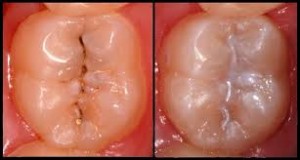What Are Fissure Sealants?
Our back teeth have natural grooves and pits known as fissures. Food can get stuck in the fissures and they are harder areas to clean when brushing which can increase the risk of tooth decay. In the past they were commonly placed in children’s teeth and now there is new evidence to show that they can be as beneficial for adults.

What are sealants?
Sealants are a safe and painless way of protecting your teeth from decay. A sealant is a protective plastic coating, which is applied to the biting surfaces of the back teeth. The sealant forms a hard shield that stops food and bacteria getting into the tiny grooves in the teeth and causing tooth decay.
How do sealants work?
The sealant forms a smooth, protective barrier by covering all the little grooves and dips (pits and fissures) in the surface of the tooth. Dental decay easily starts in these grooves.
What are the benefits of sealants?
It is a simple and painless procedure which involves no drilling or injections. Along with good maintenance of the mouth they can reduce the risk of needing a filling in the future by over 90%, which is kinder on your mouth and much more cost effective in the long term.
Which teeth should be sealed?
Sealants are only applied to the back teeth – the molars and premolars. These are the teeth that have pits and fissures on their biting surfaces. Some teeth naturally form with deep grooves which can be sealed, others form with shallow ones which may not need sealing.
When should this be done?
Sealants are often applied as soon as the adult teeth start to come through. This is usually between 6 and 7 years of age. The rest are usually sealed as soon as they appear, which can be any time between 11 and 14. They can however be applied at any age as the condition of our mouth and dental needs can change over time.
What is involved and is it painful?
Sealing is usually quick and straightforward, taking only a few minutes for each tooth. The tooth is thoroughly cleaned, prepared with a special solution, and then dried. The liquid sealant is then put onto the tooth and then set by using a blue light. The procedure is completely pain free, you may just find it feels a bit strange on biting at first and you mouth may taste a bit funny.
How long does the sealants last?
Sealants usually last for many years, but your dentist will want to check them regularly to make sure that the seal is still intact. They can wear over time, and sometimes the dentist needs to add or replace some sealant to make sure that no decay can start underneath.
Do I still have to clean my teeth?
Yes. This is really important. The smooth, sealed surface is now much easier to keep clean and healthy with normal tooth brushing. It is important to clean your teeth well, maintain a balanced diet and visit your dentist regularly. Pit and fissure sealing reduces tooth decay and the number of fillings you might need but cannot take the risk away if you don’t maintain your mouth
Where can I find out more about the treatment?
At Brightside Dental, all of our dentists and hygienists are experienced in the placement of fissure sealants. We can give you more information about the treatment and whether it would be beneficial for you at your next visit.
If you don’t want to wait until then and would like advice please give us a call on 020 88884401.

